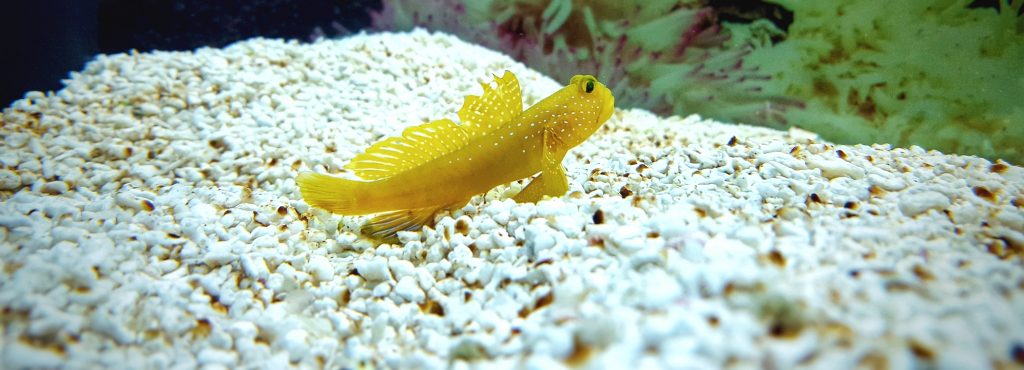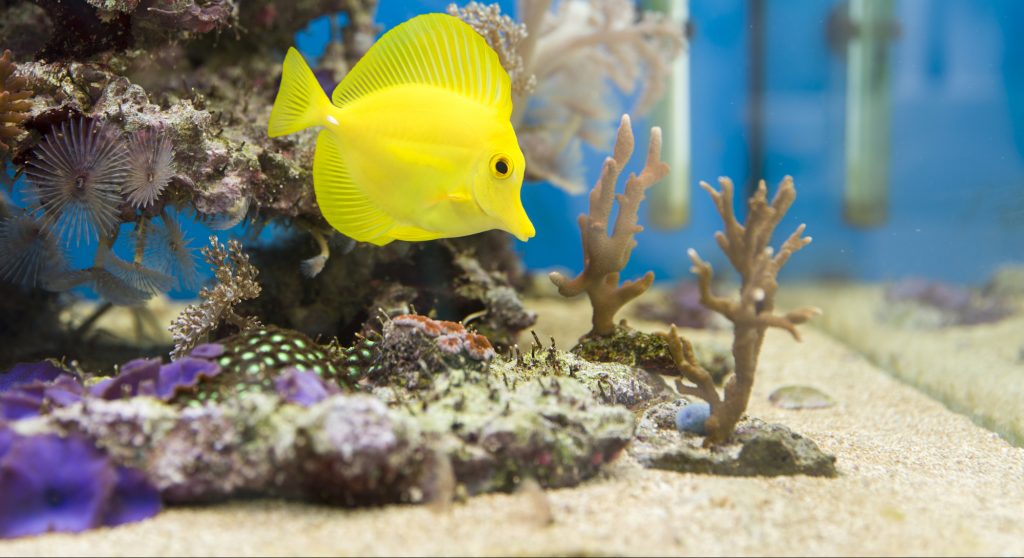Over the decades the aquarium hobby has come to better embrace the interconnected nature of its components. As in natural ecosystems, both the organic and inorganic aspects of the aquarium environment offer important benefits that are greater than the sum of their parts.
Live sand is a prime example of how this thinking can benefit the long term health of your reef aquarium. So what is live sand and why is it important in marine aquariums?
What is Live Sand?
At first the term sounds strange, doesn’t it? “Live sand?” How is sand living? As it turns out, sand is a highly dynamic environment on par with the reef itself!

Micro organisms, worms, plankton, tiny crustaceans like gammarus and copepods, starfish, clams, shrimp, and fish all make the sand bed their home. But the bacteria are what we’re going to focus on for now.
Bacteria are generally thought of as just “germs.” Problem single celled creatures that we should always be looking to clean up or at best, ignore. However, there are several genera of beneficial microorganisms that without their help, your reef tank would crash. These are the nitrifying and denitrifying bacteria (if you’re curious, that’s Nitrosomonas , Nitrobacter, Pseudomonas, and several others).
On my website, Build Your Aquarium, we thoroughly explore the cycling process and how to effectively manage it! But a quick breakdown here should suffice!
Nitrifying bacteria feed on ammonia and nitrite, two problem chemicals for all aquariums. Animals release ammonia as a waste product and it’s also a byproduct of the decay of organic debris like leftover food and poop. In the expanse of the ocean it never accumulates to toxic levels but in an aquarium it doesn’t take long for it to become toxic.
The first class of bacteria consume ammonia, releasing the nitrogen as nitrite (NO2). Nitrite is less toxic than ammonia but is still problematic if allowed to accumulate.
Fortunately, a second set of nitrifying bacteria eat that, oxidizing it further into nitrate (NO3). Nitrate is fairly well tolerated by most organisms, though it eventually becomes toxic past 20-30 ppm, depending on the animals in question.

Low levels of nitrate are useful for coral growth, though. Their photosynthetic algae symbiotes feed on it and it’s the least toxic fertilizer of the three compounds.
These nitrifying bacteria typically live in your filter, live rock, and water column. But the substrate is often overlooked by aquarists when in fact, it provides far more surface area than any other place in your aquarium! In a mature aquarium, the substrate is a highly biologically active place full of nitrifying bacteria working alongside your filter to consume nitrogenous wastes! So with enough time, you’ll have live sand no matter what you do.
So where does buying live sand fit into this? Essentially, you can buy a 100% primed and ready to go biological filter for your tank! This jump-starts the cycling process and avoids new tank syndrome, where rising ammonia, nitrite, and nitrate levels can rise beyond the ability of your low levels of bacteria to consume, causing stress to corals and fish.
But wait, there’s more! There’s an additional step to the process that live sand specifically helps facilitate! In most aquariums, the reduction of ammonia to nitrate stops there. Nitrate then starts to accumulate and then needs to be removed through water changes. But there is another class of organisms that can eat up this nitrate: de-nitrifying bacteria!
Denitrifying bacteria consume nitrate, reducing it to nitrogen gas, which harmlessly outgasses into the atmosphere and completing the Nitrogen cycle. The reason why denitrifying bacteria are hard to rely on though is because the majority of aquariums are highly oxygenated, especially those with non-sand substrates. These bacteria are anaerobic, meaning they hate oxygen. But…A deep enough live sand bed provides them with an environment where they can escape the ravages of oxygen poisoning.
Most filters use filter floss, foam, and/or ceramic media to provide space for microorganisms to form colonies. However, it takes tremendously small pore sizes to prevent oxygenated water from deeply penetrating them. Live sand beds deeper than 2 inches provide space for anaerobic bacteria to break down nitrates. And multicellular sand colonizing organisms like worms and crustaceans provide just enough aeration to keep toxic gases like hydrogen sulfide from accumulating.
It sounds like a complicated, delicate balance to have a living filter in your reef tank but it’s not one that you need to manage. The organisms do it all on their own!
Do I Need to Buy 100% Live Sand?
Live sand is highly beneficial but it’s hard to ignore that some brands are significantly pricier than standard sand blends. I believe the jump-start to your biological filtration system is well worth the price of admission. But what if you want the benefits at a reduced cost?
In that case, it’s fine to use a 50-50% blend of live sand to sterile marine sand. Remember, live sand is just regular sand that’s fully colonized by healthy organisms. Adding basic sand to your live sand will provide new real estate for these organisms to grow into. Within a few months your entire substrate will be just as potent as if you’d purchased 100% live sand to begin with.
Live Sand Feeds Your Reef Inhabitants
Another benefit of using live sand is that healthy microorganism colonies foster the health and growth of your other aquarium inhabitants. Sand sifting and detritus feeding organisms have access to a readily available food source that normally takes months or even years to accumulate if you start your tank with sterile sand.

Other organisms include tiny crustaceans that live inside this freshly collected reef sand. These will be eaten by corals, anemones, fish, and other animals. If you keep grazers like Mandarin Gobies, they can be impossible to keep alive without a steady source of tiny living prey. Live sand provides a place for these organisms to thrive.
Conclusion
As you can see, live sand provides a ton of benefits with no real drawbacks. It’s effective, attractive, and provides instant benefits. Yet it’s very simple and safe to use!
One last thing to remember: Live Sand does technically have an expiration date! The organisms within use minute amounts of oxygen but they are still living. Most live sand bags therefore have a “best before” date printed on them that you should stick to when shopping for it. Good luck and let me know how your live sand adventure goes over at Build Your Aquarium!









Hello there brilliant piece of info
Aswell as my substrate in the main aquarium of about 2/3 inch if correct would it be beneficial to have a deep sand bed in my sump ,if so how deep and how big would it need for around 1500ltrs or would the main aquarium substrate be enough ,many many thanks
Dave
Thank you so much for this article. I am a beginner at keeping a reef aquarium and have definitely got the bug for it.
It’s going to become a new and fascinating worthwhile hobby.
Once again thank you so much for your informative article it’s going to get me off to the best start possible.